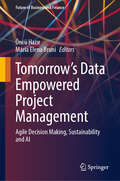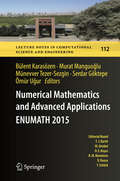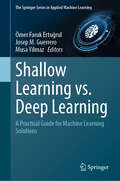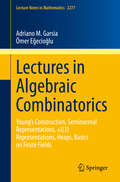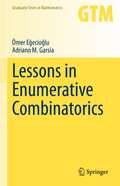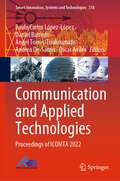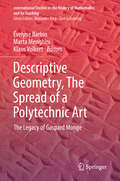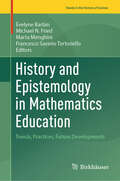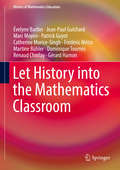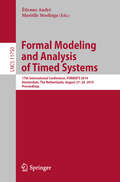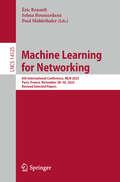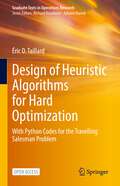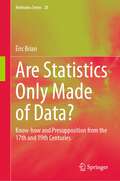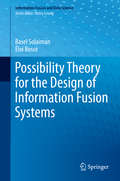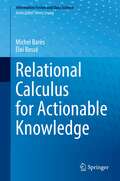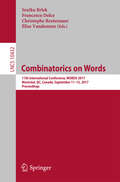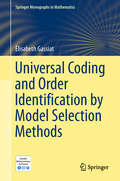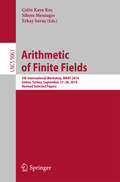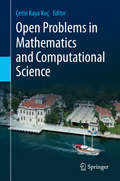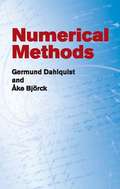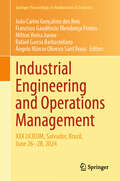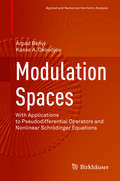- Table View
- List View
Tomorrow's Data Empowered Project Management: Agile Decision Making, Sustainability and AI (Future of Business and Finance)
by Öncü Hazır Maria Elena BruniProject management (PM) has been an essential area that deals with various decision-making problems. It offers various opportunities to conduct academic studies, formulate new models to solve business problems, and develop software and decision support systems (DSS). It has been attracting the attention of academicians and professionals involved in project teams who studied different disciplines. This book explores contemporary industry problems and trends and related promising research areas, shedding light on the future of project management. It contains chapters that focus on new technology applications and organizational trends. The book comprises two parts: new technologies and recent developments in organizing projects. An important characteristic of this book is to gather the managers and academics who conduct theoretical studies in this field to discuss the future of project management. The discussion topics include how data analytics and artificial intelligence developments might shape project life cycle management and how the Fourth/Fifth Industrial Revolution and the new technologies will transform project management practices. The importance of sustainability in project management practices is elaborated on. Recent developments in the organization of projects, such as adopting agile techniques, establishing project management offices, and developing maturity models, are discussed. As such, the book is aimed at a diverse audience of undergraduate and graduate students and practitioners seeking to develop their project management knowledge.
Numerical Mathematics and Advanced Applications ENUMATH 2015
by Bülent Karasözen Murat Manguoğlu Münevver Tezer-Sezgin Serdar Göktepe Ömür UğurThe European Conference on Numerical Mathematics and Advanced Applications (ENUMATH), held every 2 years, provides a forum for discussing recent advances in and aspects of numerical mathematics and scientific and industrial applications. The previous ENUMATH meetings took place in Paris (1995), Heidelberg (1997), Jyvaskyla (1999), Ischia (2001), Prague (2003), Santiago de Compostela (2005), Graz (2007), Uppsala (2009), Leicester (2011) and Lausanne (2013). This book presents a selection of invited and contributed lectures from the ENUMATH 2015 conference, which was organised by the Institute of Applied Mathematics (IAM), Middle East Technical University, Ankara, Turkey, from September 14 to 18, 2015. It offers an overview of central recent developments in numerical analysis, computational mathematics, and applications in the form of contributions by leading experts in the field.
Shallow Learning vs. Deep Learning: A Practical Guide for Machine Learning Solutions (The Springer Series in Applied Machine Learning)
by Josep M. Guerrero Ömer Faruk Ertuğrul Musa YilmazThis book explores the ongoing debate between shallow and deep learning in the field of machine learning. It provides a comprehensive survey of machine learning methods, from shallow learning to deep learning, and examines their applications across various domains. Shallow Learning vs Deep Learning: A Practical Guide for Machine Learning Solutions emphasizes that the choice of a machine learning approach should be informed by the specific characteristics of the dataset, the operational environment, and the unique requirements of each application, rather than being influenced by prevailing trends. In each chapter, the book delves into different application areas, such as engineering, real-world scenarios, social applications, image processing, biomedical applications, anomaly detection, natural language processing, speech recognition, recommendation systems, autonomous systems, and smart grid applications. By comparing and contrasting the effectiveness of shallow and deep learning in these areas, the book provides a framework for thoughtful selection and application of machine learning strategies. This guide is designed for researchers, practitioners, and students who seek to deepen their understanding of when and how to apply different machine learning techniques effectively. Through comparative studies and detailed analyses, readers will gain valuable insights to make informed decisions in their respective fields.
Lectures in Algebraic Combinatorics: Young's Construction, Seminormal Representations, SL(2) Representations, Heaps, Basics on Finite Fields (Lecture Notes in Mathematics #2277)
by Adriano M. Garsia Ömer EğecioğluCapturing Adriano Garsia's unique perspective on essential topics in algebraic combinatorics, this book consists of selected, classic notes on a number of topics based on lectures held at the University of California, San Diego over the past few decades. The topics presented share a common theme of describing interesting interplays between algebraic topics such as representation theory and elegant structures which are sometimes thought of as being outside the purview of classical combinatorics. The lectures reflect Garsia’s inimitable narrative style and his exceptional expository ability. The preface presents the historical viewpoint as well as Garsia's personal insights into the subject matter. The lectures then start with a clear treatment of Alfred Young's construction of the irreducible representations of the symmetric group, seminormal representations and Morphy elements. This is followed by an elegant application of SL(2) representations to algebraic combinatorics. The last two lectures are on heaps, continued fractions and orthogonal polynomials with applications, and finally there is an exposition on the theory of finite fields. The book is aimed at graduate students and researchers in the field.
Lessons in Enumerative Combinatorics (Graduate Texts in Mathematics #290)
by Adriano M. Garsia Ömer EğecioğluThis textbook introduces enumerative combinatorics through the framework of formal languages and bijections. By starting with elementary operations on words and languages, the authors paint an insightful, unified picture for readers entering the field. Numerous concrete examples and illustrative metaphors motivate the theory throughout, while the overall approach illuminates the important connections between discrete mathematics and theoretical computer science. Beginning with the basics of formal languages, the first chapter quickly establishes a common setting for modeling and counting classical combinatorial objects and constructing bijective proofs. From here, topics are modular and offer substantial flexibility when designing a course. Chapters on generating functions and partitions build further fundamental tools for enumeration and include applications such as a combinatorial proof of the Lagrange inversion formula. Connections to linear algebra emerge in chapters studying Cayley trees, determinantal formulas, and the combinatorics that lie behind the classical Cayley–Hamilton theorem. The remaining chapters range across the Inclusion-Exclusion Principle, graph theory and coloring, exponential structures, matching and distinct representatives, with each topic opening many doors to further study. Generous exercise sets complement all chapters, and miscellaneous sections explore additional applications. Lessons in Enumerative Combinatorics captures the authors' distinctive style and flair for introducing newcomers to combinatorics. The conversational yet rigorous presentation suits students in mathematics and computer science at the graduate, or advanced undergraduate level. Knowledge of single-variable calculus and the basics of discrete mathematics is assumed; familiarity with linear algebra will enhance the study of certain chapters.
Communication and Applied Technologies: Proceedings of ICOMTA 2022 (Smart Innovation, Systems and Technologies #318)
by Paulo Carlos López-López Daniel Barredo Ángel Torres-Toukoumidis Andrea De-Santis Óscar AvilésThis book features selected papers from the International Conference on Communication and Applied Technologies (ICOMTA 2022), jointly organized by the Universidad del Rosario (Bogotá, Colombia) and the Universidad Politécnica Salesiana (Cuenca, Ecuador), and as collaborators at the University of Vigo (Galicia, Spain), the University of Santiago de Compostela-Political Research Team (Galicia, Spain), and the Network of Communication Researchers of Ecuador (RICE), during August, 31–September 2, 2022. It covers recent advances in the field of digital communication and processes, digital social media, software, big data, data mining, and intelligent systems.
Descriptive Geometry, The Spread of a Polytechnic Art: The Legacy of Gaspard Monge (International Studies in the History of Mathematics and its Teaching)
by Klaus Volkert Évelyne Barbin Marta MenghiniThis book seeks to explore the history of descriptive geometry in relation to its circulation in the 19th century, which had been favoured by the transfers of the model of the École Polytechnique to other countries. The book also covers the diffusion of its teaching from higher instruction to technical and secondary teaching. In relation to that, there is analysis of the role of the institution – similar but definitely not identical in the different countries – in the field under consideration. The book contains chapters focused on different countries, areas, and institutions, written by specialists of the history of the field. Insights on descriptive geometry are provided in the context of the mathematical aspect, the aspect of teaching in particular to non-mathematicians, and the institutions themselves.
History and Epistemology in Mathematics Education: Trends, Practices, Future Developments (Trends in the History of Science)
by Michael N. Fried Évelyne Barbin Marta Menghini Francesco Saverio TortorielloThis book explores the evolving relationship between the history and epistemology of mathematics and mathematics education over the past fifty years. Beginning with the international movement that emerged in the 1970s, it celebrates the enduring and expanding role of historical and epistemological perspectives in shaping teaching practices. Organized into seven thematic sections, the volume examines core issues such as how historical and epistemological insights enhance understanding of mathematical concepts, interdisciplinarity as a tool for teaching, and innovative approaches to teacher training. It also delves into the use of historical problems, ancient texts, and textbooks as teaching resources, alongside an analysis of the social and political dimensions of mathematics education. Special attention is given to the impact of the "modern mathematics" reform and its legacy in rekindling interest in the history of mathematics in education. Featuring contributions from diverse geographical and historical contexts, this book is an essential resource for teachers, researchers, and anyone passionate about the rich interplay of history, epistemology, and mathematics.
Let History into the Mathematics Classroom
by Évelyne Barbin Jean-Paul Guichard Marc Moyon Patrick Guyot Catherine Morice-Singh Frédéric Métin Martine Bühler Dominique Tournès Renaud Chorlay Gérard HamonThis book brings together 10 experiments which introduce historical perspectives into mathematics classrooms for 11 to 18-year-olds. The authors suggest that students should not only read ancient texts, but also should construct, draw and manipulate. The different chapters refer to ancient Greek, Indian, Chinese and Arabic mathematics as well as to contemporary mathematics. Students are introduced to well-known mathematicians--such as Gottfried Leibniz and Leonard Euler--as well as to less famous practitioners and engineers. Always, there is the attempt to associate the experiments with their scientific and cultural contexts. One of the main values of history is to show that the notions and concepts we teach were invented to solve problems. The different chapters of this collection all have, as their starting points, historic problems--mathematical or not. These are problems of exchanging and sharing, of dividing figures and volumes as well as engineers' problems, calculations, equations and congruence. The mathematical reasoning which accompanies these actions is illustrated by the use of drawings, folding, graphical constructions and the production of machines.
Formal Modeling and Analysis of Timed Systems: 17th International Conference, FORMATS 2019, Amsterdam, The Netherlands, August 27–29, 2019, Proceedings (Lecture Notes in Computer Science #11750)
by Mariëlle Stoelinga Étienne AndréThis book constitutes the refereed proceedings of the 17th International Conference on Formal Modeling and Analysis of Timed Systems, FORMATS 2019, held in Amsterdam, The Netherlands, in August 2019.The 15 full papers and 2 short papers presented in this volume were carefully reviewed and selected from 42 submissions. The papers are organized in the following topical sections: special session on data-driven and stochastic approaches to real-time, including monitoring and Big Data; timed systems; linear and non-linear systems; timed automata; special session on timed systems and probabilities.
Machine Learning for Networking: 6th International Conference, MLN 2023, Paris, France, November 28–30, 2023, Revised Selected Papers (Lecture Notes in Computer Science #14525)
by Selma Boumerdassi Éric Renault Paul MühlethalerThis book constitutes the refereed proceedings of the 6th International Conference on Machine Learning for Networking, MLN 2023, held in Paris, France, during November 28–30, 2023. The 18 full papers included in this book were carefully reviewed and selected from 34 submissions. The conference aims at providing a top forum for researchers and practitioners to present and discuss new trends in machine learning, deep learning, pattern recognition and optimization for network architectures and services.
Special Relativity in General Frames: From Particles to Astrophysics
by Éric GourgoulhonSpecial relativity is the basis of many fields in modern physics: particle physics, quantum field theory, high-energy astrophysics, etc. This theory is presented here by adopting a four-dimensional point of view from the start. An outstanding feature of the book is that it doesn't restrict itself to inertial frames and to considering accelerated and rotating observers. It is thus possible to treat physical effects such as the Thomas precession or the Sagnac effect in a simple yet precise manner. In the final chapters, more advanced topics like tensorial fields in spacetime, exterior calculus and relativistic hydrodynamics are addressed. In the last, brief chapter the author gives a preview of gravity and shows where it becomes incompatible with Minkowsky spacetime. Well illustrated and enriched by many historical notes, this book also presents many applications of special relativity, ranging from particle physics (accelerators, particle collisions, quark-gluon plasma) to astrophysics (relativistic jets, active galactic nuclei), and including practical applications (Sagnac gyrometers, synchrotron radiation, GPS). In addition, the book provides some mathematical developments, such as the detailed analysis of the Lorentz group and its Lie algebra. The book is suitable for students in the third year of a physics degree or on a masters course, as well as researchers and any reader interested in relativity. Thanks to the geometric approach adopted, this book should also be beneficial for the study of general relativity. "A modern presentation of special relativity must put forward its essential structures, before illustrating them using concrete applications to specific dynamical problems. Such is the challenge (so successfully met!) of the beautiful book by Éric Gourgoulhon." (excerpt from the Foreword by Thibault Damour)
Design of Heuristic Algorithms for Hard Optimization: With Python Codes for the Travelling Salesman Problem (Graduate Texts in Operations Research)
by Éric D. TaillardThis open access book demonstrates all the steps required to design heuristic algorithms for difficult optimization. The classic problem of the travelling salesman is used as a common thread to illustrate all the techniques discussed. This problem is ideal for introducing readers to the subject because it is very intuitive and its solutions can be graphically represented. The book features a wealth of illustrations that allow the concepts to be understood at a glance. The book approaches the main metaheuristics from a new angle, deconstructing them into a few key concepts presented in separate chapters: construction, improvement, decomposition, randomization and learning methods. Each metaheuristic can then be presented in simplified form as a combination of these concepts. This approach avoids giving the impression that metaheuristics is a non-formal discipline, a kind of cloud sculpture. Moreover, it provides concrete applications of the travelling salesman problem, which illustrate in just a few lines of code how to design a new heuristic and remove all ambiguities left by a general framework. Two chapters reviewing the basics of combinatorial optimization and complexity theory make the book self-contained. As such, even readers with a very limited background in the field will be able to follow all the content.
Are Statistics Only Made of Data?: Know-how and Presupposition from the 17th and 19th Centuries (Methodos Series #20)
by Éric BrianThis book examines several epistemological regimes in studies of numerical data over the last four centuries. It distinguishes these regimes and mobilises questions present in the philosophy of science, sociology and historical works throughout the 20th century. Attention is given to the skills of scholars and their methods, their assumptions, and the socio-historical conditions that made calculations and their interpretations possible. In doing so, questions posed as early as Émile Durkheim’s and Ernst Cassirer’s ones are revisited and the concept of symbolic form is put to the test in this particular survey, conducted over long period of time. Although distinct from a methodological and epistemological point of view, today these regimes may be found together in the toolbox of statisticians and those who comment on their conclusions. As such, the book is addressed to social scientists and historians and all those who are interested in numerical productions.
Possibility Theory for the Design of Information Fusion Systems (Information Fusion and Data Science)
by Éloi Bossé Basel SolaimanThis practical guidebook describes the basic concepts, the mathematical developments, and the engineering methodologies for exploiting possibility theory for the computer-based design of an information fusion system where the goal is decision support for industries in smart ICT (information and communications technologies). This exploitation of possibility theory improves upon probability theory, complements Dempster-Shafer theory, and fills an important gap in this era of Big Data and Internet of Things.The book discusses fundamental possibilistic concepts: distribution, necessity measure, possibility measure, joint distribution, conditioning, distances, similarity measures, possibilistic decisions, fuzzy sets, fuzzy measures and integrals, and finally, the interrelated theories of uncertainty..uncertainty. These topics form an essential tour of the mathematical tools needed for the latter chapters of the book. These chapters present applications related to decision-making and pattern recognition schemes, and finally, a concluding chapter on the use of possibility theory in the overall challenging design of an information fusion system. This book will appeal to researchers and professionals in the field of information fusion and analytics, information and knowledge processing, smart ICT, and decision support systems.
Relational Calculus for Actionable Knowledge (Information Fusion and Data Science)
by Éloi Bossé Michel BarèsThis book focuses on one of the major challenges of the newly created scientific domain known as data science: turning data into actionable knowledge in order to exploit increasing data volumes and deal with their inherent complexity. Actionable knowledge has been qualitatively and intensively studied in management, business, and the social sciences but in computer science and engineering, its connection has only recently been established to data mining and its evolution, ‘Knowledge Discovery and Data Mining’ (KDD). Data mining seeks to extract interesting patterns from data, but, until now, the patterns discovered from data have not always been ‘actionable’ for decision-makers in Socio-Technical Organizations (STO). With the evolution of the Internet and connectivity, STOs have evolved into Cyber-Physical and Social Systems (CPSS) that are known to describe our world today. In such complex and dynamic environments, the conventional KDD process is insufficient, and additional processes are required to transform complex data into actionable knowledge. Readers are presented with advanced knowledge concepts and the analytics and information fusion (AIF) processes aimed at delivering actionable knowledge. The authors provide an understanding of the concept of ‘relation’ and its exploitation, relational calculus, as well as the formalization of specific dimensions of knowledge that achieve a semantic growth along the AIF processes. This book serves as an important technical presentation of relational calculus and its application to processing chains in order to generate actionable knowledge. It is ideal for graduate students, researchers, or industry professionals interested in decision science and knowledge engineering.
Combinatorics on Words: 11th International Conference, WORDS 2017, Montréal, QC, Canada, September 11-15, 2017, Proceedings (Lecture Notes in Computer Science #10432)
by Christophe Reutenauer Srečko Brlek Francesco Dolce Élise VandommeThe two parts of this text are based on two series of lectures delivered by Jean Berstel and Christophe Reutenauer in March 2007 at the Centre de Recherches Mathematiques, Montreal, Canada. Part I represents the first modern and comprehensive exposition of the theory of Christoffel words. Part II presents numerous combinatorial and algorithmic aspects of repetition-free words stemming from the work of Axel Thue--a pioneer in the theory of combinatorics on words. A beginner to the theory of combinatorics on words will be motivated by the numerous examples, and the large variety of exercises, which make the book unique at this level of exposition. The clean and streamlined exposition and the extensive bibliography will also be appreciated. After reading this book, beginners should be ready to read modern research papers in this rapidly growing field and contribute their own research to its development. Experienced readers will be interested in the finitary approach to Sturmian words that Christoffel words offer, as well as the novel geometric and algebraic approach chosen for their exposition. They will also appreciate the historical presentation of the Thue-Morse word and its applications, and the novel results on Abelian repetition-free words.
Universal Coding and Order Identification by Model Selection Methods (Springer Monographs in Mathematics)
by Élisabeth Gassiat Anna Ben-HamouThe purpose of these notes is to highlight the far-reaching connections between Information Theory and Statistics. Universal coding and adaptive compression are indeed closely related to statistical inference concerning processes and using maximum likelihood or Bayesian methods. The book is divided into four chapters, the first of which introduces readers to lossless coding, provides an intrinsic lower bound on the codeword length in terms of Shannon’s entropy, and presents some coding methods that can achieve this lower bound, provided the source distribution is known. In turn, Chapter 2 addresses universal coding on finite alphabets, and seeks to find coding procedures that can achieve the optimal compression rate, regardless of the source distribution. It also quantifies the speed of convergence of the compression rate to the source entropy rate. These powerful results do not extend to infinite alphabets. In Chapter 3, it is shown that there are no universal codes over the class of stationary ergodic sources over a countable alphabet. This negative result prompts at least two different approaches: the introduction of smaller sub-classes of sources known as envelope classes, over which adaptive coding may be feasible, and the redefinition of the performance criterion by focusing on compressing the message pattern. Finally, Chapter 4 deals with the question of order identification in statistics. This question belongs to the class of model selection problems and arises in various practical situations in which the goal is to identify an integer characterizing the model: the length of dependency for a Markov chain, number of hidden states for a hidden Markov chain, and number of populations for a population mixture. The coding ideas and techniques developed in previous chapters allow us to obtain new results in this area. This book is accessible to anyone with a graduate level in Mathematics, and will appeal to information theoreticians and mathematical statisticians alike. Except for Chapter 4, all proofs are detailed and all tools needed to understand the text are reviewed.
The Theory of Spinors
by Élie CartanThe French mathematician Élie Cartan (1869-1951) was one of the founders of the modern theory of Lie groups, a subject of central importance in mathematics and also one with many applications. In this volume, he describes the orthogonal groups, either with real or complex parameters including reflections, and also the related groups with indefinite metrics. He develops the theory of spinors (he discovered the general mathematical form of spinors in 1913) systematically by giving a purely geometrical definition of these mathematical entities; this geometrical origin makes it very easy to introduce spinors into Riemannian geometry, and particularly to apply the idea of parallel transport to these geometrical entities.The book is divided into two parts. The first is devoted to generalities on the group of rotations in n-dimensional space and on the linear representations of groups, and to the theory of spinors in three-dimensional space. Finally, the linear representations of the group of rotations in that space (of particular importance to quantum mechanics) are also examined. The second part is devoted to the theory of spinors in spaces of any number of dimensions, and particularly in the space of special relativity (Minkowski space). While the basic orientation of the book as a whole is mathematical, physicists will be especially interested in the final chapters treating the applications of spinors in the rotation and Lorentz groups. In this connection, Cartan shows how to derive the "Dirac" equation for any group, and extends the equation to general relativity.One of the greatest mathematicians of the 20th century, Cartan made notable contributions in mathematical physics, differential geometry, and group theory. Although a profound theorist, he was able to explain difficult concepts with clarity and simplicity. In this detailed, explicit treatise, mathematicians specializing in quantum mechanics will find his lucid approach a great value.
Arithmetic of Finite Fields: 5th International Workshop, WAIFI 2014, Gebze, Turkey, September 27-28, 2014. Revised Selected Papers (Lecture Notes in Computer Science #9061)
by Çetin Kaya Koç Sihem Mesnager Erkay SavaşThis book constitutes the refereed proceedings of the 5th International Workshop on the Arithmetic of Finite Field, WAIFI 2014, held in Gebze, Turkey, in September 2014. The 9 revised full papers and 43 invited talks presented were carefully reviewed and selected from 27 submissions. This workshop is a forum of mathematicians, computer scientists, engineers and physicists performing research on finite field arithmetic, interested in communicating the advances in the theory, applications, and implementations of finite fields. The workshop will help to bridge the gap between the mathematical theory of finite fields and their hardware/software implementations and technical applications.
Open Problems in Mathematics and Computational Science
by Çetin Kaya KoçThis book presents interesting, important unsolved problems in the mathematical and computational sciences. The contributing authors are leading researchers in their fields and they explain outstanding challenges in their domains, first by offering basic definitions, explaining the context, and summarizing related algorithms, theorems, and proofs, and then by suggesting creative solutions. The authors feel a strong motivation to excite deep research and discussion in the mathematical and computational sciences community, and the book will be of value to postgraduate students and researchers in the areas of theoretical computer science, discrete mathematics, engineering, and cryptology.
Reclaiming the Forest: The Ewenki Reindeer Herders of Aoluguya
by Åshild Kolås Yuanyuan XieThe reindeer herders of Aoluguya, China, are a group of former hunters who today see themselves as “keepers of reindeer” as they engage in ethnic tourism and exchange experiences with their Ewenki neighbors in Russian Siberia. Though to some their future seems problematic, this book focuses on the present, challenging the pessimistic outlook, reviewing current issues, and describing the efforts of the Ewenki to reclaim their forest lifestyle and develop new forest livelihoods. Both academic and literary contributions balance the volume written by authors who are either indigenous to the region or have carried out fieldwork among the Aoluguya Ewenki since the late 1990s.
Numerical Methods (Dover Books on Mathematics)
by Germund Dahlquist Åke BjörckPractical text strikes fine balance between students' requirements for theoretical treatment and needs of practitioners, with best methods for large- and small-scale computing. Prerequisites are minimal (calculus, linear algebra, and preferably some acquaintance with computer programming). Text includes many worked examples, problems, and an extensive bibliography.
Industrial Engineering and Operations Management: XXX IJCIEOM, Salvador, Brazil, June 26–28, 2024 (Springer Proceedings in Mathematics & Statistics #483)
by Milton Vieira Junior Rafael Garcia Barbastefano João Carlos Gonçalves dos Reis Francisco Gaudêncio Mendonça Freires Ângelo Márcio Oliveira Sant’AnnaThis proceedings gathers selected, peer-reviewed papers presented at the XXX International Joint Conference on Industrial Engineering and Operations Management (IJCIEOM), held from June 26 to 28, 2024, in Salvador, Brazil. The works in this volume explores critical areas such as Supply Chain risk models, last-mile delivery optimization, stochastic inventory models, and human development focusing on digital training for operations management in emergencies. Tailored to benefit academics, the volume comprises studies predominantly rooted in real-world case studies, systematic, and meta-reviews, offering valuable insights also for professionals within the industrial sector by presenting solutions to intricate industrial challenges.
Modulation Spaces: With Applications to Pseudodifferential Operators and Nonlinear Schrödinger Equations (Applied and Numerical Harmonic Analysis)
by Kasso A. Okoudjou Árpád BényiThis monograph serves as a much-needed, self-contained reference on the topic of modulation spaces. By gathering together state-of-the-art developments and previously unexplored applications, readers will be motivated to make effective use of this topic in future research. Because modulation spaces have historically only received a cursory treatment, this book will fill a gap in time-frequency analysis literature, and offer readers a convenient and timely resource.Foundational concepts and definitions in functional, harmonic, and real analysis are reviewed in the first chapter, which is then followed by introducing modulation spaces. The focus then expands to the many valuable applications of modulation spaces, such as linear and multilinear pseudodifferential operators, and dispersive partial differential equations. Because it is almost entirely self-contained, these insights will be accessible to a wide audience of interested readers.Modulation Spaces will be an ideal reference for researchers in time-frequency analysis and nonlinear partial differential equations. It will also appeal to graduate students and seasoned researchers who seek an introduction to the time-frequency analysis of nonlinear dispersive partial differential equations.
